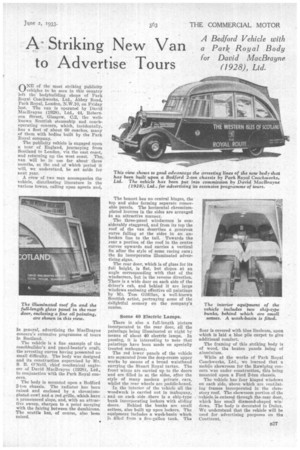A Striking New Van to Advertise Tours
Page 45

If you've noticed an error in this article please click here to report it so we can fix it.
A Bedford Vehicle with a Park Royal Body for David MacBrayne (1928), Ltd.
ONE of the most striking publicity vehiOes to be seen in this country left the bodybuilding shops of Park Royal Coachworks, Ltd., Abbey Road, Park Royal, London, N.W.10, on Friday last. The van is operated by David MacBrayne (1928), Ltd., 44, Robertson Street, Glasgow, C.2, the wellknown Scottish steamship and coachoperating concern, which, incidentally, has a fleet of about 60 coaches, many of them with bodies built by the Park Royal company.
The publicity vehicle is engaged upon a tour of England, journeying from Scotland to London, via the east coast, end returning up the west coast. The van will be in use for about three months, at the end of which period it will, we understand, be set aside for next year.
A crew of two men accompanies the vehicle, distributing literature in the various towns, calling upon agents and, in general, advertising the MacBrayne concern's extensive programme of tours in Scotland.
The vehicle is a fine example of the coachbuilder's and panel-beater's craft, . the arresting curves having presented no small difficulty. The body was designed and its construction supervised by Mr. S. B. O'Neill, chief mechanical engin-. eer of David MacBrayne (1928), Ltd., in conjunction with the Park Royal concern.
The body is mounted upon a Bedford 2-ton chassis. The radiator has been raised and enclosed by a chromiumplated-cowl and.a red grille, which have n Pronounced slope, and, with an attractive sweep, sharpen to a point merging with the fairing between the dumbirons. The scuttle has, of course, also been raised. The bonnet has no central hinges, the top and sides forming separate removable panels. The horizontal chromiumplated louvres in the sides are arranged in an attractive manner.
The three-panel windscreen is considerably staggered, and from its top the roof of the van describes a generous curve falling at the sides in an unbroken line to the tail. Towards the rear a portion of the roof in the centre curves upwards and carries a vertical fin after the style of some racing cars; the fin incorporates illuminated advertising signs.
The rear door, which is of glass for its full height, is flat, but slopes at an angle corresponding with that of the windscreen, but in the reverse direction. There is a wide door on each side of the driver's cab, and behind it are large windows enclosing effective oil paintings by Mr. Tom Gilfillan, a well-known Scottish artist, portraying some of the delightful scenery on the company's routes.
Some 40 Electric Lamps.
There is also a full-length picture incorporated in the rear door, all the paintings being illuminated at night by means of about 40 electric lamps. In passing, it is interesting to note that paintings have been made on specially treated mahogany.
The red lower panels of the vehicle are separated from the deep-cream upper works by means of a broad waistband carrying the Stuart Royal tartan. The front wings are carried up to the doors and are filled in at the sides, after the style of many modern private ears, whilst the rear wheels are paddle-boxed.
In the interior of the vehicle all the woodwork is carried out in mahogany, and on each -side there is a ship-type bunk incorporating lockers with sliding doors. Behind the bunks are small settees, also built up upon lockers. The equipment includes a wash-basin which is filled from a five-gallon tank. The
floor is covered with blue linoleum, upon which is laid a blue pile carpet to give additional comfort.
The framing of this striking body is of wood, the beaten panels being of aluminium.
While at the works of Park Royal Coachworks, Ltd., we learned that a mobile showroom for the Rawlplug concern was under construction, this being mounted upon a Ford 2-ton chassis.
The vehicle has four hinged windows on each side, above which are ventilating frames incorporated in the clerestory roof. The showroom portion of the .vehicles is entered through the rear door, which has small diamond-shaped win: dows. The body is decorated in Dulux. We understand that the vehicle will be used for advertising purposes on tho Continent.




































































































